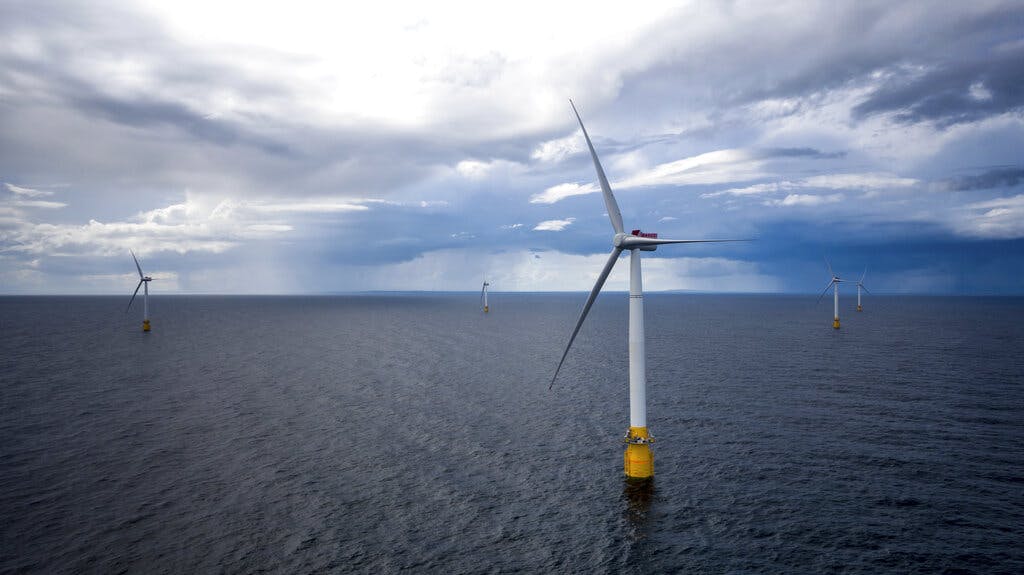World’s Largest Offshore Wind Firm Facing Bureaucratic, Financial Headwinds in America
The company’s chief executive tells analysts that it may be forced to abandon its eight nascent projects off the shores of New England, a potential blow to President Biden’s ambitious and costly green energy agenda.

Green energy enthusiasts’ dreams of hundreds of giant windmills off the coasts of the United States took another hit Wednesday when the world’s largest producer of the required turbines reported steep losses and warned of “severe” setbacks in its American operations.
The Danish firm, Orsted, which also operates wind farms in Britain’s North Sea, said it may be forced to take a $2.3 billion hit on its U.S. portfolio because of snarls in the supply chain, rising interest rates, and slowing taxpayer subsidies from the Biden administration.
The company’s chief executive, Mads Nipper, told analysts on a conference call following its announcement that it may be forced to abandon its eight nascent projects off the shores of New York, Rhode Island, Connecticut, Maryland, and New Jersey. There are currently only two functioning offshore wind farms in America, off the coasts of Rhode Island and Virginia; Orsted owns and operates the Rhode Island farm.
“If the walk-away scenario is the economical, rational decision for us, then this remains a real scenario for us as an alternative to actually taking the final investment decision,” Mr. Nipper said. The company lost about 25 percent of its market value on the news Wednesday. Mr. Nipper said the woes faced by his company are exclusive to the American market.
“We still believe in the long term potential of the U.S. market but something needs to happen short-term in order for this industry to be scalable,” he told analysts. “It’s extremely important that the federal government takes this as seriously as they possibly can if they still intend to have scalable offshore wind.”
The Biden administration has made offshore wind a cornerstone of its green energy policies and backed that up with billions of dollars in tax credits and other subsidies courtesy of the trillion-dollar Inflation Reduction Act passed last year. The administration set a goal of generating 30 gigawatts a year from offshore wind farms by the end of the decade, a feat that would require at least 2,000 turbines off America’s coastlines.
The problem for Orsted and others trying to capitalize on those incentives are century-old bureaucratic headwinds and union-friendly rules regarding domestically produced materials and laborers that are attached to the handouts.
One hurdle is the 1920 Jones Act, which requires that any cargo moving between points on United States territory be carried by American-made vessels crewed by U.S. citizens. There are currently no U.S.-flagged vessels equipped to build the platforms and carry the turbines needed to erect the giant windmills. A ship titled the Jones Act Enforcer, manned by a marine-industry lobby, the Offshore Marine Service Association, patrols the waters off the East Coast, documenting violations of the Jones Act.
Another is the strings that come with Mr. Biden’s green energy subsidies. In order to receive the tax credits that make the projects financially viable, companies must prove that between 40 percent and 55 percent of the materials used in the construction of the project come from domestic sources. Companies must also pay union-level prevailing wages and have other union-friendly policies in order to qualify for the tax credits.
Environmentalists have also raised concerns about the possibility that the huge projects have contributed to the unprecedented number of whales washing up dead on the shores of New England. Since December 2022, 23 dead whales have washed up on Northeast beaches, and dozens more have been found dead floating just offshore. Support for the projects in places such as New Jersey has plunged in recent months as a result.
A poll released this week by Monmouth University suggests that just more than half of the state’s residents support offshore wind farms, compared to three-fourths who said they supported them as recently as February. “There was a time when wind energy was not really a political issue,” the director of Monmouth’s Polling Institute, Patrick Murray, said. “It consistently received widespread bipartisan support for more than a decade. That is no longer the case.”
Beyond Orsted’s troubles, further evidence that the free market may not be as enthusiastic as climate activists in the Biden administration about the prospects of offshore wind farms came Tuesday in the first-ever auction of development rights in the Gulf of Mexico, which had been hailed as a milestone in the president’s plans. A single, disappointing $5.6 million bid came in for one plot off the coast of Louisiana, and no bids at all were received for two others.

